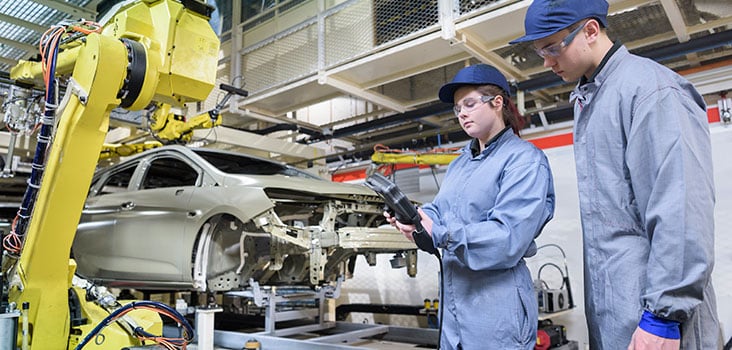
Managing the Risk of Robotics in the Workplace
We rely on robots to complete everyday tasks – we ask Siri about the weather, clean our homes with automated vacuums, and get directions from the GPS in our cars. Employers are also getting in on the act, employing robotic technology to help increase productivity and improve service delivery.
Robots aren’t just metallic humanoids speaking in monotone. Think of them as any automated process that a machine does instead of a person, from a simple tool like a calculator to a more complex machine that helps build cars. These robots are built to make jobs easier and faster, but they have their downsides. And when employers bring robots into the workplace, there are several safety factors to consider.
From the pros and cons, to the uses and safety protocols, here’s what you need to know about robots in the workplace.
How are robots being used in the workplace?
For the most part, companies are using robots to increase productivity. Tablets take your order at restaurants, drones deliver your packages, and apps on your phone help you deposit checks.
While some people may be concerned that robots are taking their jobs, these machines are often used to help humans complete tasks more efficiently. Robots can manage and sort massive sets of data, work in dangerous or difficult environments, and master an almost perfect level of precision. But without a strategy behind its use, it’s important to remember that they are still pieces of machinery.
The pros and cons of working robots
Although robots present new possibilities for production levels in the workplace, they come with their fair share of hassles and risks. Having a full picture of how these machines impact work, from the benefits to the downfalls, can help employers determine whether a robot is the right fit for their workplace.
The pros
Robots can help take on the jobs that humans just can’t. Machines can be built to withstand hazardous conditions and work long hours without breaks. They can manage heavy material and complete dull, repetitive tasks without making mistakes. Replacing humans with robots can help reduce accident risks typically associated with these unsafe or tedious jobs.
There can also be a lower cost associated with “hiring” robots. A machine may cost $30,000, but that’s a one-time payment. Even with update and repair costs over time, the costs are still lower than a salaried employee.
The cons
Sometimes those lower costs aren’t worth it. As beneficial as robots can be in certain positions, there are some things that only humans can do. When it comes to tasks that include creativity, decision-making, and adapting, humans have the advantage.
Robots can also be dangerous coworkers, especially during non-routine tasks like maintenance and programming. Across 30 years of OSHA incident reports, there were 37 robot-related accidents cited, 27 of which resulted in a worker’s death. That may seem small in comparison to the 4,585 workplace fatalities in 2013 alone, but one death is still too many.
Before employers can enjoy the positives of using robots at work, they need to ensure their employees’ safety with a plan to control the negatives.
How to safely use robots at work
Before you put a robot to work, make sure you’ve prepared your workplace and your workforce with the proper safety protocols. Luckily, you don’t have to start from scratch. The Occupational Safety and Health Administration (OSHA) offers guidelines for robotics safety, and the National Institute for Occupational Safety and Health (NIOSH) shares injury prevention recommendations.
Focusing on the safety elements related to non-routine tasks (the ones more likely to result in an accident), here are four important elements to include in a robot safety program.
Control of hazardous energy (lockout/tagout)
OSHA requires workers to remove a machine’s power source and lock/tag the disconnect before performing maintenance activities. Basically, before you start working on the machine, make sure it’s unplugged and that only the person performing maintenance can plug it back in. The lockout/tagout procedure helps prevent the machine from going rogue during maintenance and harming the person working.
Safeguarding
Make sure to include the appropriate safety guards for the robotic workstation, including a safety fence, presence-sensing device, and braking system. However, it’s also important to design safeguarding systems that allow easy access to get work done quickly and safely. Patrick Davison, Director of Standards Development for the Robotic Industries Association (RIA), stresses that if a specific safeguard prevents the robot user from completing their task, they will find a way to defeat that safeguarding, putting themselves in greater danger.
Risk assessment
It’s essential for anyone who works with the robot to take part in risk assessment, including the programmers and maintenance team. This process involves understanding the risks and hazards of the machine and the tasks required (both routine and non-routine). Including multiple perspectives from employees who will complete different tasks with the robot will help provide a fuller picture of those risks. Once you know the risks, you can take steps to prevent accidents and develop training.
Training
Introducing any new tool or program into the workplace should involve training. Before any employee starts working with the robot, they need to understand how it works and how to safely interact with it. Training should include a review of the risks, demonstrations and practice runs, and safety protocols for when things go wrong.
Robots can be an exciting addition to the workplace, as long as you’re prepared to manage the risks. Follow the guidelines set by OSHA and seek advice or help if you need it. For any additional questions you have about maintaining a safe workplace, contact a Concentra work safety expert.



